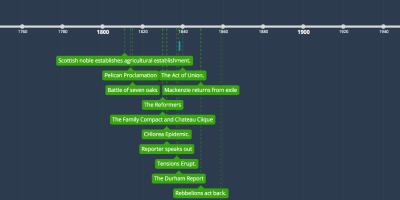Rebelion starts (dec 25, 1837 – oct 16, 1838)
Description:
Tensions in Canada wererising throughout the 1830s between those in power and those who wanted
change. In 1837 and 1838, the political conflict in Upper and Lower Canada
exploded into violent rebellions, or uprisings, throughout the colony.After the War of 1812, much of the best unfarmed land was given to wealthy
British immigrants.As a result, many Canadien and Loyalist farmers were forced to farm on land
with poor soil, where it was hard to grow crops. Crop failure left families in
poverty, and sometimes near starvation. Many Canadien farmers were forced
to leave their farms to take low-paying jobs in nearby cities.Poverty in Upper and Lower Canada was growing. In Lower Canada, most
of the wealthy families were British.In both Upper
and Lower Canada, many poor people felt that rich people were ignoring
their suffering. At the same time, a growing middle class of professionals
(doctors, lawyers, and journalists) were making more money and wanted to
have more power and influence. However, the existing government structure
kept these people out of positions of power.After the riot between French Reformers and British Loyalists on
November 6, 1837, described on page 223, the Patriotes began to organize
rallies and prepare for a rebellion. They also began to boycott British
goods. British troops were sent into Lower Canada to stop the unrest. On
November 16, 1837, the government in Lower Canada tried to arrest some of
the leaders of the Parti Patriote. About 800 Patriotes replied with an armed
uprising at Saint-Denis on November 23, winning the battle when the British
retreated. Two days later, after the British army added 400 more soldiers,
the Patriotes were defeated during the battle of Saint-Charles,After the battles at Saint-Denis and Saint-Charles, the Patriotes regrouped
and took their last stand north of Montréal, in Saint-Eustache. On the
morning of December 14, 1837, about 1280 British soldiers and 220 Loyalist
volunteers faced the remaining 200 Patriote fighters.After a short fight in Saint-Eustache, the armed rebellion in Lower
Canada was over. The victorious British army then looted and burned the
houses of the rebels. Papineau and the other leaders of the rebellion fled to
the United States. The remaining Patriote fighters who were unable to flee
were either killed or taken prisoner by the British. In Lower Canada, polices became dangerous.In Upper Canada, the Tories had used the support of recent British
immigrants to win the 1836 election. However, they had also used bribery
and corruption to win. They had gained the support of the new British
immigrants by branding the Reformers as dangerous radicals. As a result,
riots broke out between Mackenzie’s Reformers angered by the Tory
campaign and the supporters of the Tories during the election. This was
much like the riot that had broken out during the 1832 election in Montréal.When Lieutenant-Governor Sir Francis Bond Head found out about the
uprising in Lower Canada, he sent the troops who were stationed in
Upper Canada to help defeat the rebels. Mackenzie realized that the conflict
in Lower Canada was distracting the British. He saw an opportunity for
Reformers in Upper Canada to stage their own rebellion.On December 5, 1837, Mackenzie and about 800 supporters marched
down Yonge Street in Toronto.Later that evening, the rebels were able to regroup and reorganize under
the command of an experienced military leader. However, the British
forces were able to gather more troops, and they now numbered 1000
men. Two days later, the rebels were defeated, and the British burned
down Montgomery’s Tavern. Another group of rebels, from the London,
Ontario, area, tried to join Mackenzie, but they, too, were easily defeated by
government forces. Tory supporters burned homes and farms belonging
to known rebels and even those belonging to people who were only
suspected people.The rebellion of Upper Canada was over. Mackenzie managed to escape to
the United States, but some of his followers were captured. Two of them,
Samuel Lount and Peter Matthews, were tried and then hanged.
Added to timeline:
Date:
dec 25, 1837
oct 16, 1838
~ 9 months
